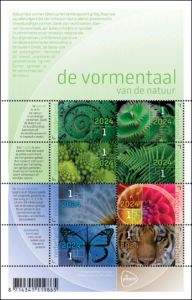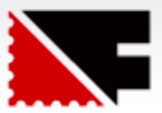[from PostNL press material] [click on any of the pictures for larger versions]
The Design Language Of Nature
Date of issue: 22 April 2024
Format: sheet with eight stamps in eight different designs, with denomiation 1 for post up to and including 20 grams for destinations within the Netherlands
Item number: 440561
Design: Sandra Smulders, Vormgoed, Gouda
 PostNL will issue The Design Language Of Nature stamp sheet on 22 April 2024. The stamps feature photographs of unusual geometric shapes found in nature with patterns such as spirals, symmetry, fractals, Fibonacci sequences and the golden ratio. It was designed by Sandra Smulders. The denomination on these stamps is ‘1’, the denomination for items weighing up to 20g with destinations in the Netherlands. A sheet of eight stamps costs €8.72 (currently US$9.28).
PostNL will issue The Design Language Of Nature stamp sheet on 22 April 2024. The stamps feature photographs of unusual geometric shapes found in nature with patterns such as spirals, symmetry, fractals, Fibonacci sequences and the golden ratio. It was designed by Sandra Smulders. The denomination on these stamps is ‘1’, the denomination for items weighing up to 20g with destinations in the Netherlands. A sheet of eight stamps costs €8.72 (currently US$9.28).
People in every culture throughout the world use regular patterns to decorate artefacts and other objects. We also observe these patterns in nature, based on geometrical shapes such as rectangles, star patterns, circles, spheres and cylinders. When these shapes are combined, all sorts of complex patterns emerge underpinned by mathematical principles.
The Design Language Of Nature stamps feature photographs of plants and animals that display these geometrical patterns, including spirals (a curved line around a defined point that gets ever closer or further away from the point) and symmetry (where one half of an object is the mirror image of the other half). Other patterns represented include fractals (where geometric shapes are precisely replicated in different sizes) and Fibonacci sequences (a sequence in which each element is the sum of the two preceding elements). These four regular patterns are linked together on the stamp sheet using the golden ratio, sometimes referred to as the divine proportion, that is also observable in nature. In the golden ratio, the largest of two parts is in proportion to the smallest part, while the whole is in proportion to the largest part. The ratio found is called the golden number and is denoted by the Greek letter phi.
The Design Language Of Nature stamps depict the following animals and plants: panther chameleon and Christmas tree worm (spirals), romanesco cauliflower and fern (fractals),  dandelion, sunflower, nautilus shell and dahlia (Fibonacci sequence), monarch butterfly and tiger (symmetry).
dandelion, sunflower, nautilus shell and dahlia (Fibonacci sequence), monarch butterfly and tiger (symmetry).
Smulders laid out the stamp sheet itself in the aesthetically pleasing proportions of the golden ratio. A multitude of rectangles of different sizes formed by white lines is overlaid on each stamp. In the golden ratio, the largest rectangle is in proportion to the smallest while all the rectangles together are in proportion to the largest rectangle. The proportions of the stamps and of the stamp sheet in relation to one another are also determined by the golden ratio.
A white line taking the form of a spiral is traced across the stamp sheet. The spiral starts in the smallest two rectangles on the yellow/red shaded stamp. From this point, the colours on the stamps change as the spiral moves over the page: from yellow to orange, through red, brown, blue and finally to various shades of green on the stamps at the top. On the sheet edges and the tabs, pale colours matching those in the photographs on the stamps fade into one another. The year and denomination 1 appear in the white rectangles on the stamps. The country appears vertically along the edge of the stamp outside the photograph. The explanatory text on the tabs traces the curve of the spiral and, on the bottom edge of the sheet, the typography and the PostNL logo remain within the spiral. An explanatory text appears at the top left on the sheet edge.
“From my research it became clear that the Design Language Of Nature comes in vastly differing forms,” says Smulders. “I chose to focus only on flora and fauna for the stamps, but there are so many natural phenomena in which you can observe geometric shapes: from snowflakes and clouds, to schools of fish and the effects of the wind on sand in deserts.
“All these shapes and their behaviour are underpinned by mathematical formulae. That’s what makes it so fascinating.”
For the eight stamps, Smulders chose four geometric shapes: spirals, fractals, Fibonacci sequences and symmetry. She then set about putting together a selection of images she could use, within certain parameters. “For example, there needed to be a balance between flora and fauna”, continues Smulders. “So, an equal number of plants and animals. Colours also played a role in my design decisions.”
Technical Details:
Stamp size: 114.721 x 179.442mm:
Sheet format: 40 x 24.721 mm
Paper: normal with phosphor print
Glue: gummed
Printing technique: offset
Printing colours: cyan, magenta, yellow and black
Edition: 95,000 sheets
Format: sheet of 8 stamps in 8 different designs
Design: Sandra Smulders, Vormgoed, Gouda
Printing company: Koninklijke Joh. Enschedé B.V., Haarlem
Item number: 440561
 Note: PostNL does not sell directly to collectors in North America. Its website refers to a company called Nordfirm, which says it sells Dutch new issues at face value. The Virtual Stamp Club has no connection to this company.
Note: PostNL does not sell directly to collectors in North America. Its website refers to a company called Nordfirm, which says it sells Dutch new issues at face value. The Virtual Stamp Club has no connection to this company.
 Collectors may also wish to contact the U.S. firm Bombay Stamps, which can also obtain first day covers upon request, with lower shipping fees. The email is sales@bombaystamps.com Again, The Virtual Stamp Club has no connection to this company.
Collectors may also wish to contact the U.S. firm Bombay Stamps, which can also obtain first day covers upon request, with lower shipping fees. The email is sales@bombaystamps.com Again, The Virtual Stamp Club has no connection to this company.



